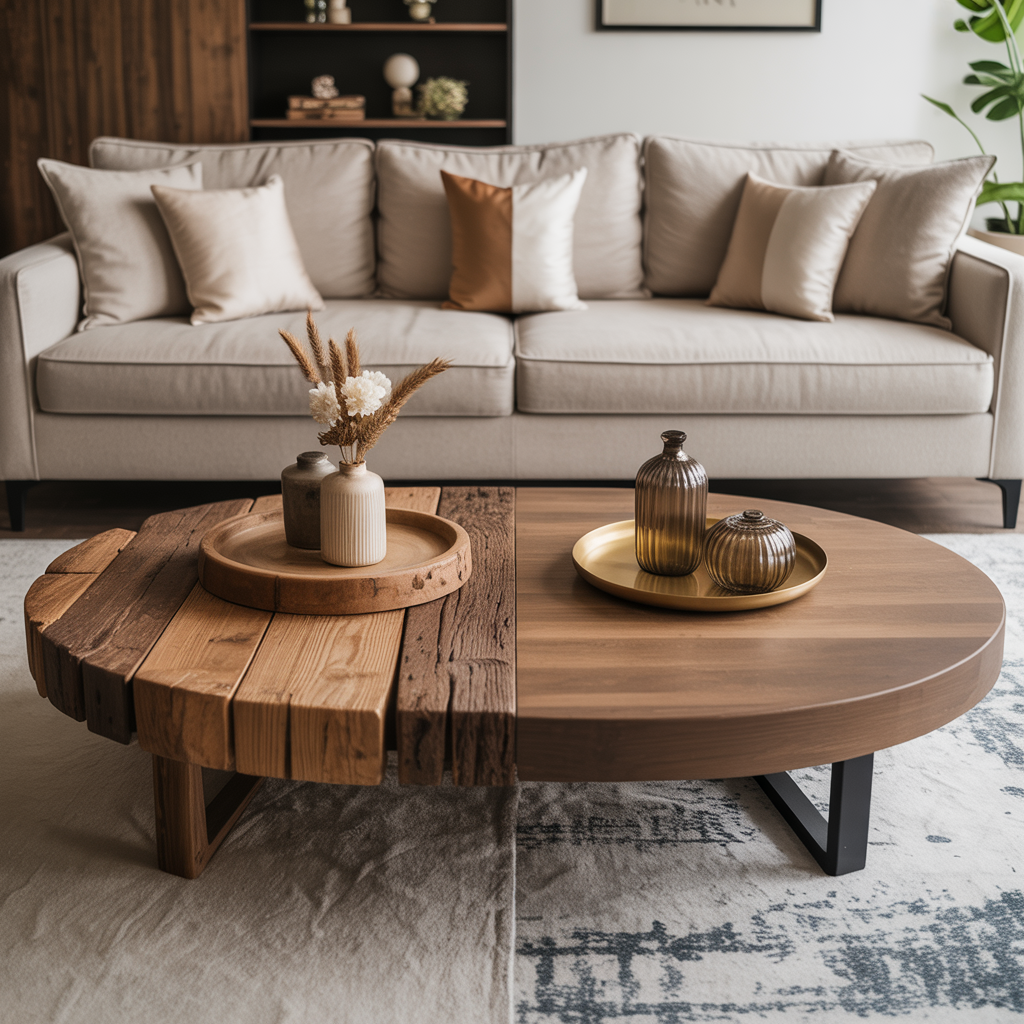Coffee Table Inspiration & Styling Ideas
Rustic vs Modern Coffee Tables: Which Style Fits Your Space?
1. The Heart of the Living Room
A coffee table isn’t just practical; it sets the tone for your entire seating area. It interacts closely with your sofa, side tables, and even your TV stand. Choosing between rustic and modern styles is essentially choosing the story your living room tells — earthy comfort or refined clarity.
2. What Defines a Rustic Coffee Table
Rustic design celebrates nature and craftsmanship. These tables feature solid wood, visible grain, knots, and imperfections that add authenticity. Common materials include reclaimed timber, oak, or pine. The look is tactile — warm tones, matte finishes, and sometimes hand-tooled edges or live-edge slabs.
- Material: Solid or reclaimed wood with a hand-finished surface.
- Color palette: Warm browns, honey tones, or weathered grays.
- Hardware: Often blackened steel, iron, or antique brass details.
- Feel: Inviting, grounded, and full of character.
A rustic coffee table pairs beautifully with soft furnishings, linen upholstery, and neutral color schemes. It introduces texture and warmth — perfect for homes seeking comfort and natural charm.
3. What Defines a Modern Coffee Table
Modern coffee tables emphasize simplicity and geometry. Think clean lines, thin profiles, and smooth finishes. They might incorporate metal frames, tempered glass, or lacquered wood. The goal is visual lightness — minimal ornamentation and functional elegance.
- Material: Wood veneer, stone, metal, or glass.
- Color palette: Neutrals, blacks, whites, and subtle contrast.
- Hardware: Hidden fittings or sleek brushed metals.
- Feel: Refined, uncluttered, and quietly luxurious.
Modern tables work beautifully in contemporary spaces with open layouts and minimalist furniture. Their simplicity makes them ideal for pairing with statement décor — artwork, lighting, or architectural elements.
4. Comparing Key Features
| Aspect | Rustic | Modern |
|---|---|---|
| Material | Solid, reclaimed, or natural wood | Metal, glass, veneer, or mixed media |
| Texture | Raw, matte, tactile | Smooth, glossy, sleek |
| Color tones | Warm browns and honey tones | Monochrome or contrasting neutrals |
| Design goal | Comfort, character, natural appeal | Clarity, simplicity, refinement |
5. How to Choose What Fits Your Space
Your lifestyle and architecture will guide your decision. Ask yourself:
- Do you value handcrafted detail and organic materials?
- Or do you prefer streamlined shapes and low-maintenance finishes?
Rustic designs excel in cozy living rooms or spaces that already feature natural materials like stone, rattan, or linen. Modern tables shine in bright, open rooms with minimal clutter and clean architectural lines. Explore the diversity of both aesthetics in our Coffee Tables collection — from solid wood slabs to metal-framed glass tops.
6. Blending Rustic and Modern
You don’t have to choose just one. Mixing styles can add sophistication and depth. A rustic oak table surrounded by sleek metal-leg chairs can look perfectly balanced. Likewise, a modern table atop a woven rug introduces contrast that feels natural.
The secret is harmony — pair contrasting textures within a unified palette. A modern table works well beside rustic shelving or a wood storage cabinet if both share similar undertones.
7. Styling Your Coffee Table
Regardless of style, thoughtful styling completes the scene. Use the “rule of three”: combine one tall element (like a vase), one medium (a stack of books), and one small (a bowl or candle). Keep negative space — less is more. To explore arrangement ideas, visit our Coffee Table Inspiration & Styling Ideas blog. For broader composition across side pieces, see End & Side Table Design & Placement Tips.
8. Creating Harmony Across the Living Room
Your coffee table should converse with other pieces. Align finishes and proportions with your side tables and TV stands for unity. If your cabinet or console features natural wood, echo that tone on smaller surfaces for cohesion.
When pairing with storage or décor, balance open and closed surfaces — rustic pieces favor open shelves and tactile materials, while modern units often conceal clutter. Explore our Storage Cabinet & Decor Ideas for how storage furniture supports style consistency.
9. Final Thoughts
Whether rustic or modern, your coffee table should reflect how you live. Rustic designs bring authenticity and comfort; modern ones bring calm and precision. Both can coexist beautifully when chosen with intent and balance. At Greyzing, we craft furniture that bridges tradition and innovation — timeless wooden surfaces with contemporary forms. Explore our full collections of Coffee Tables, End & Side Tables, TV Stands, and Storage Cabinets to design a living room that’s uniquely yours. For deeper styling insight, browse our editorial guides like TV Stand Style & Function Guide and Storage Cabinet & Decor Ideas.

